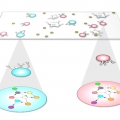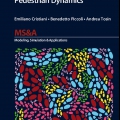
Computational multi-scale modeling
The challenges of multi-scale modeling in biology and medicine
One of the greatest challenges in biomedicine is to get a unified view of observations made from the molecular (microscopic) to the cellular (mesoscopic) up to the organism (macroscopic) scale. Towards this goal, multiscale models have been highly instrumental in contexts such as the cardiovascular field, angiogenesis, neurosciences and tumour biology. More recently, such models are becoming an increasingly important resource to address immunological questions as well. Multiscale modelling aims at integrating the mathematical and computational description of processes operating at variable spatial, temporal and organizational levels. In the past 20 years, it has become an established resource to investigate diverse physiopathological processes. Examples can be found in the cardiovascular field, neural systems, tumour growth, vasculature formation, epidermal wound healing and tissue engineering.
Systematic literature mining reveals that one of the most recent and rapidly developing trends in MSM research is given by immunological applications. In this context, attempts are being made to deepen our understanding of infection and inflammatory processes, and to suggest improved treatments of widespread immunological disorders.
Modeling the immune system and inflammation is paradigmatic of the well-known technical difficulties arising from bridging different modelling paradigms at different scales (e.g. discrete and continuous, deterministic and stochastic models, fast and slow characteristic times, etc.). Further issues involve the management of numerical instabilities deriving from models formulated at different scales; problems concerning parameter estimation; sensitivity of simulation results to large numbers of parameters; control and optimization problems; large computational requirements; standardization and reusability of the models developed.
One more consideration that comes out from latest research is that multiscale models of the immune system is likely unachievable at this time in anything but discrete (i.e. low granularity) models at least for what concerns the mesoscopic scale. This has pros and cons. The well-known benefits of working with agent-based models have to be weighted with the disadvantage coming from the fact that the granularity of discrete models encapsulates general concepts more than quantitative terms. Therefore, though good for assessing how well separate concepts fit together, such multiscale modeling is less likely to achieve high accuracy and may lead investigators down a wrong path. With the explosion of the “omics” data, a fundamental open problem in multiscale modeling is to link data from genomics, transcriptomics and metabolomics studies to higher-level phenotypic characteristics.
Multiscale immunological models directly target a wide range of pathologies with the hope to help assessing the efficacy of treatments, and to optimize therapeutic regimens. In this respect, such models clearly fall within the scope of computational system medicine in particularly when considering the possibility to tailor the models on patient-specific immunological signatures. Notably, these words fully resonate with the mission of the Virtual Physiological Human initiative, which, among other goals, aims at integrating whole organ models into a unified computer model of the human organism able to predict the response to ‘therapeutic perturbations’ of different physiological and pathological conditions.
A team at the Institute IAC-CNR, has implemented one of such model in the contest of the EU project MISSION-T2D devoted to model type 2 diabetes. For this pathology it is crucial to combine models of the inflammation taking place at a cellular (immune) level with models of the metabolism which lays at the molecular level. Moreover, a proper description of the immune inflammation as a quite complex phenomena, requires the integration of inter-cellular dynamics (i.e. a description of the mesoscopic scale) with intra-cellular specification of gene activation and regulation events (which pertain to the microscopic scale).
Along this line, the team has implemented, in the specific case of the differentiation process of the CD4 T-helper lymphocyte cell type into four distinct phenotypes including the pro- and the anti-inflammatory as well as macrophage cell type differentiation into equivalent characters, a combination of agent-based methodology with Boolean networks.
This work illustrates that multiscale models can consistently integrate immunological data generated at several scales, and can be used to describe and optimize therapeutic treatments of complex immune diseases, and, once validated, it will provide a valuable tool for the physician in the diagnostics and treatment of this disease. Furthermore, our models will provide emotionally engaging, real-time, personalized, nutritional, and behavioral guidance as well as health tracking for individual patients by means of a specific app currently being developed by MEDISANA, the industrial partner of the MISSION-T2D project.
In this perspective, members of the IAC are participating in the COST project Open Multiscale Systems Medicine (OpenMultiMed), which aim is to gather a critical mass of international researchers and coordinate them as a team that develops and evaluates a transdisciplinary framework for multiscale systems medicine, consisting of novel concepts, methodologies and technologies.
Links:
- MISSION http://www.mission-t2d.eu
- OPENMULTIMED http://www.cost.eu/COST_Actions/ca/CA15120
- MEDISANA http://www.medisana.com
Articles:
- A. Cappuccio, P. Tieri, and F. Castiglione. Multiscale modelling in immunology: a review. Briefings in Bioinformatics 1-11 (2015) doi:10.1093/bib/bbv012 http://bib.oxfordjournals.org/content/early/2015/03/25/bib.bbv012.full
- Castiglione et al MISSION-T2D http://www.researchprotocols.org/2013/2/e44/













